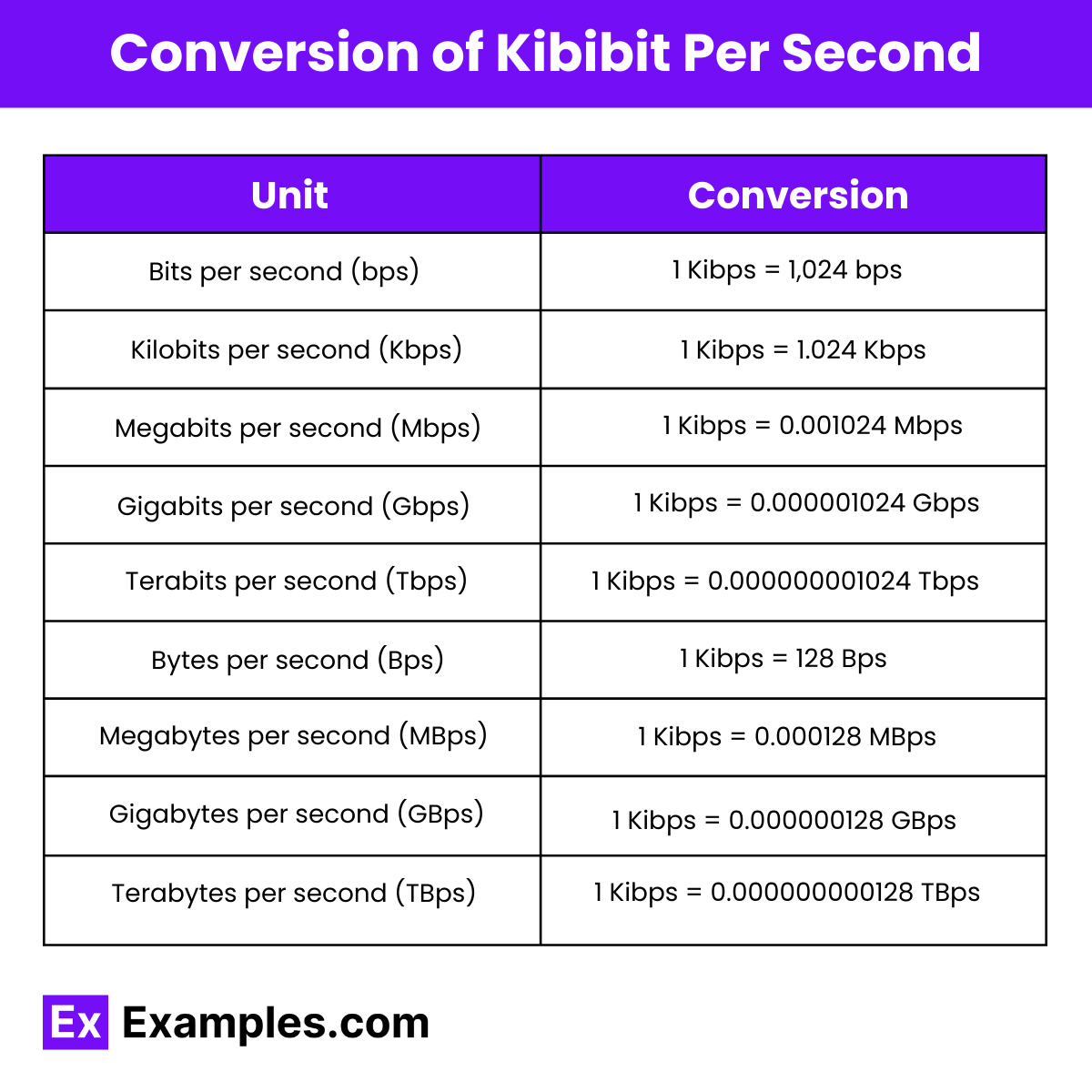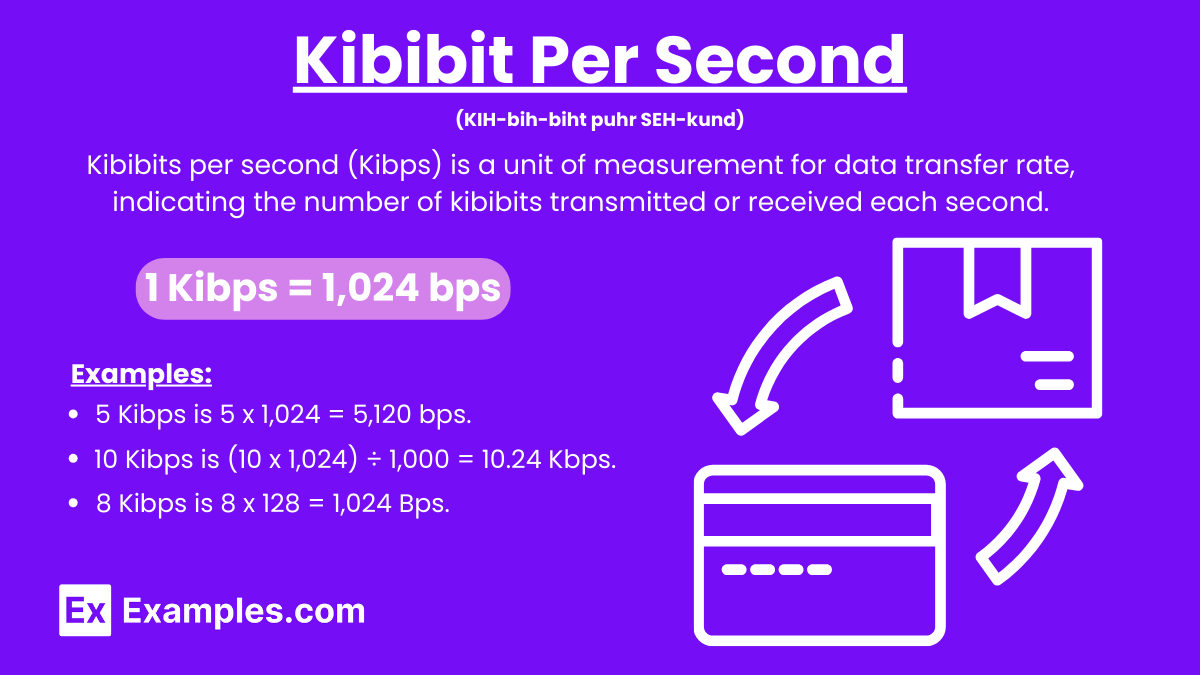15+ Kibibit Per Second Examples
Kibibits per second (Kibps) is a unit of measurement for data transfer rate, indicating the number of kibibits transmitted or received each second. A kibibit is equivalent to 1,024 bits, which aligns with the binary system used in computing and data processing. This unit is commonly used to quantify data transfer speeds in networks, computer systems, and digital communication channels, providing a precise measurement that reflects the binary nature of digital data. In different contexts, other units of speed are used, such as foot per second, meter per second, and miles per second, to measure the velocity of objects. Each of these units provides a specific way to understand the rate at which something moves over a given second, whether it’s data through a network or physical objects in motion.
What is Kibibit Per Second?
Kibibits per second (Kibps) measures how quickly data is transmitted over a network, with one kibibit equal to 1,024 bits. This unit, based on the binary system, is used to describe data transfer speeds in digital communication and computing, providing a more precise measurement than standard kilobits per second. Understanding units of measurement is essential in various fields, including data transfer rates. Different measurement units are used to quantify speed and length, such as meters or feet. A measurement chart can help convert between these units, ensuring accuracy and clarity in communication.
Examples of Kibibit Per Second
- Transferring a simple text file
- Downloading a basic email attachment
- Syncing contacts on a mobile device
- Uploading a short text document
- Streaming a low-quality a file
- Loading a simple webpage
- Updating metadata for music files
- Downloading small configuration files
- Sending a quick photo via a messaging app
- Uploading a small PDF document
- Streaming a basic podcast episode
- Transferring a small compressed image
- Downloading small software updates
- Syncing a small note in a cloud service
- Uploading a short voice memo
Kibibit Per Second Formula
The formula to calculate the data transfer rate in kibibits per second (Kibps) is:
Data Transfer Rate (Kibps) = Time Taken (Seconds)/Total Data Transferred (Kibibits)
Steps to Use the Formula
- Determine the Total Data Transferred
- Measure the total amount of data transferred.
- Convert this amount to kibibits (Kib). If the data is in bits, divide the total number of bits by 1,024 to get kibibits.
- Measure the Time Taken
- Measure the total time taken for the data transfer in seconds.
- Apply the Formula
- Divide the total data transferred (in kibibits) by the time taken (in seconds) to get the data transfer rate in kibibits per second (Kibps).
Conversion of Kibibit Per Second

| Unit | Conversion |
|---|---|
| Bits per second (bps) | 1 Kibps = 1,024 bps |
| Kilobits per second (Kbps) | 1 Kibps = 1.024 Kbps |
| Megabits per second (Mbps) | 1 Kibps = 0.001024 Mbps |
| Gigabits per second (Gbps) | 1 Kibps = 0.000001024 Gbps |
| Terabits per second (Tbps) | 1 Kibps = 0.000000001024 Tbps |
| Bytes per second (Bps) | 1 Kibps = 128 Bps |
| Kilobytes per second (KBps) | 1 Kibps = 0.128 KBps |
| Megabytes per second (MBps) | 1 Kibps = 0.000128 MBps |
| Gigabytes per second (GBps) | 1 Kibps = 0.000000128 GBps |
| Terabytes per second (TBps) | 1 Kibps = 0.000000000128 TBps |
Understanding how to convert data transfer rates to other common units is crucial when dealing with different data speeds, whether you’re configuring network settings, comparing internet speeds, or ensuring accurate data rates for projects. Here’s a straightforward guide to converting data transfer rates to and from other common units:
Kibibits per second (Kibps) to Bits per second (bps)
Multiply the Kibps value by 1,024 to convert to bps.
Example: 5 Kibps is 5 x 1,024 = 5,120 bps.
Kibibits per second (Kibps) to Kilobits per second (Kbps)
Multiply the Kibps value by 1,024, then divide by 1,000 to convert to Kbps.
Example: 10 Kibps is (10 x 1,024) ÷ 1,000 = 10.24 Kbps.
Kibibits per second (Kibps) to Megabits per second (Mbps)
Multiply the Kibps value by 1,024, then divide by 1,000,000 to convert to Mbps.
Example: 2,048 Kibps is (2,048 x 1,024) ÷ 1,000,000 = 2.097 Mbps.
Kibibits per second (Kibps) to Gigabits per second (Gbps)
Multiply the Kibps value by 1,024, then divide by 1,000,000,000 to convert to Gbps.
Example: 1,048,576 Kibps is (1,048,576 x 1,024) ÷ 1,000,000,000 = 1.0737 Gbps.
Kibibits per second (Kibps) to Bytes per second (Bps)
Multiply the Kibps value by 128 to convert to Bps.
Example: 8 Kibps is 8 x 128 = 1,024 Bps.
Kibibits per second (Kibps) to Kilobytes per second (KBps)
Multiply the Kibps value by 0.128 to convert to KBps.
Example: 32 Kibps is 32 x 0.128 = 4.096 KBps.
Kibibits per second (Kibps) to Megabytes per second (MBps)
Divide the Kibps value by 8,192 to convert to MBps.
Example: 16,384 Kibps is 16,384 ÷ 8,192 = 2 MBps.
Kibibits per second (Kibps) to Gigabytes per second (GBps)
Divide the Kibps value by 8,388,608 to convert to GBps.
Example: 16,777,216 Kibps is 16,777,216 ÷ 8,388,608 = 2 GBps.
Kibibits per second (Kibps) to Terabytes per second (TBps)
Divide the Kibps value by 8,589,934,592 to convert to TBps.
Example: 17,179,869,184 Kibps is 17,179,869,184 ÷ 8,589,934,592 = 2 TBps.
Importance of Kibibit Per Second
Just as KBps is used to measure data transfer rates, other units of measurement like yard, centimeter, and millimeter are used to quantify length in various contexts. Using a measurement chart helps convert between these units, providing clarity and precision in different fields of study and application.
- Precision in Measurement: Ensures accurate assessment of network and system performance.
- Standardization in Computing: Aligns with the binary system, promoting consistency.
- Optimizing Network Performance: Helps identify and resolve bottlenecks.
- Technical Specifications: Provides a standardized metric for evaluating technologies.
- Efficient Data Management: Crucial for managing large volumes of data.
- Enhancing Communication Technologies: Drives improvements in communication tech.
- Real-World Applications: Critical for downloading, streaming, and gaming.
- Capacity Planning: Aids in predicting future needs and scaling resources.
- Cost Efficiency: Helps manage costs and optimize bandwidth usage.
Where do you use of Kibibit Per Second
- Data Storage and Transfer Measurement: Kibibits per second are used to measure data transfer rates in scenarios where precision is critical. This includes transferring data between storage devices, such as hard drives, SSDs, and NAS systems, especially in computing environments that prefer binary measurement units.
- Network Performance Monitoring: Network administrators use kibibits per second to monitor and analyze network performance. This unit provides a more accurate representation of data transfer rates, especially in binary-based computing systems. Tools and software for network monitoring often display data rates in Kibps.
- Scientific Research and High-Performance Computing (HPC): In scientific research and HPC environments, data transfer rates are measured in kibibits per second to ensure precision and accuracy. This is important for tasks that involve large datasets and require high data throughput, such as simulations, data analysis, and processing.
- Data Center Operations: Data centers use Kibps to measure and manage data transfer rates between servers, storage systems, and network infrastructure. This helps in optimizing data flow, reducing bottlenecks, and ensuring efficient operation of data center resources.
- File Transfers and Backups: When transferring large files or performing backups, data transfer rates might be measured in Kibps to provide a precise understanding of the transfer speed. This is particularly useful in environments that deal with substantial data volumes and require exact measurements.
- Cloud Computing Services: Cloud service providers may use Kibps to measure and advertise data transfer rates for their services. This includes data transfer between cloud storage, virtual machines, and other cloud-based resources, ensuring transparency and accuracy in billing and performance metrics.
How does a kibibit differ from a kilobit?
A kibibit equals 1,024 bits, while a kilobit equals 1,000 bits. Kibibit uses binary, kilobit uses decimal.
Why use kibibits instead of kilobits?
Kibibits provide precise binary measurement, aligning with computer memory’s binary nature, unlike kilobits’ decimal base.
What is the abbreviation for kibibit per second?
The abbreviation for kibibit per second is Kibps.
How do kibibits per second compare to kilobytes per second?
1 Mebibit per second (Mibps) equals 1,024 Kibps. Kibibits are a smaller unit.
Can internet speed be measured in kibibits per second?
Yes, internet speed can be measured in kibibits per second, though kilobits per second is more common.
What systems use kibibits per second?
Computer networking, data storage, and digital communication systems use kibibits per second for precise measurement.
Is Kibps used in software applications?
Yes, software applications, especially those dealing with data transfer and storage, use Kibps.
Do network devices display speeds in Kibps?
Some network devices display speeds in Kibps, though Mbps (megabits per second) is more common.
How does Kibps relate to bandwidth?
Kibps measures bandwidth, indicating how much data can be transferred per second.
Are Kibps and Kbps interchangeable?
No, Kibps and Kbps are not interchangeable. Kibps is 1,024 bits per second, Kbps is 1,000 bits per second.


